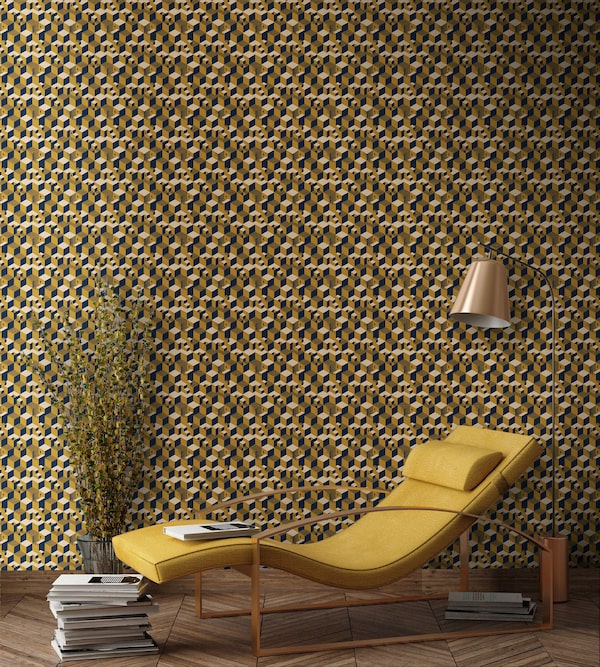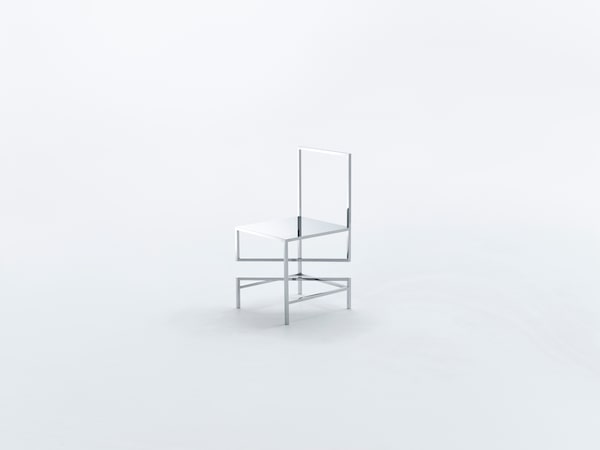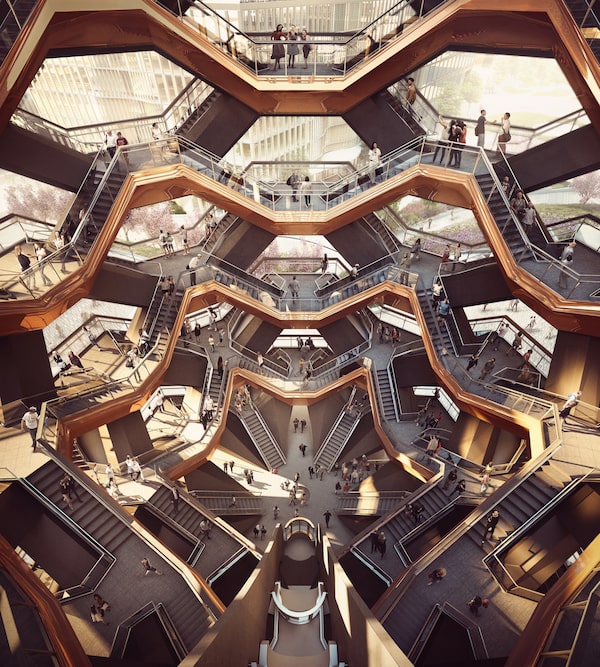
A wallpaper by Jannelli & Volpi translates M.C. Escher’s tricky patterns into the world of home decor.
By his own account, M.C. Escher was not a fine artist, but a graphic artist ''with heart and soul.'' Known for his enigmatic woodcut prints depicting impossible architectures and landscapes, visual puzzles and tessellated patterns of fish, birds and reptiles, Escher has been lauded historically for the precision and craftsmanship of his work. What might be most remarkable about the surreal aesthetic he created before his death in 1972 is how it has infiltrated the design world. From the hippie subculture of the 1960s to influential contemporary names as diverse as slick Japanese studio Nendo and decadent Italian luxury brand Gucci, the Escher effect keeps repeating itself.
Born in the Netherlands in 1898, Maurits Cornelis Escher was originally enrolled in the School for Architecture and Decorative Arts in Haarlem with the intention of becoming an architect. ''I came within a hair's breadth of having the opportunity to become a useful member of society,'' quipped Escher in a speech to accept the Hilversum culture prize in 1965.
Read the full Style Advisor: September 2018 fall edition
But it was the beauty of craft, the forced limitations of woodblock carving and the desire for his work to be produced in multiples that drew Escher to focus his interest and efforts on the graphic arts instead.

A collection of chairs by Japanese studio Nendo.
''He didn’t want to be a painter because then you could only make one painting,'' says Mark Veldhuysen, curator of the M.C. Escher Foundation, established in 1968 to preserve the artist’s legacy. ''That’s why he decided to become a graphic artist, so he could make multiple prints and more people could enjoy it.''
Veldhuysen is co-curator, with collector Federico Giudiceandrea, of Escher: The Exhibition & Experience, a travelling installation of over 200 works by the artist on view until Feb. 3 at Industry City in Brooklyn, as well as another show at the Museum of Friesland in Escher's hometown, Leeuwarden.

The topsy-turvy video game Monument Valley.
Divided into seven thematic sections, the travelling Escher exhibit begins with his early works and influences. Though he worked outside mainstream 20th-century art movements, art nouveau and the intricate, geometric tile patterns he observed on visits to the Alhambra palace in Spain inspired his interest in repetitious design. The exhibition also includes a compilation of Escher-inspired objects and ephemera, showing his indelible impact on popular culture and consumer goods. Escher famously refused Mick Jagger's request to create an original work for the Rolling Stones' 1969 record Let It Bleed, but he still made his mark on music with album covers for the likes of Pink Floyd and Scaffold.
Today, his influence is ramping up again. ''Oh, he is still being copied constantly,'' says Veldhuysen, who keeps an eye out for anything Escheresque. ''You have this video game, Monument Valley, which is based entirely on his work,'' he says. And if you look at the clothing that is on display [in the exhibition], you'll notice that he is inspiring modern designers even today.''
Monument Valley places its protagonists in implausible and ever-changing worlds, similar to Escher's mind-bending lithographs Up and Down, Relativity and Belvedere. A real-life version of such topsy-turvy environments is being built at Hudson Yards in New York, designed by Heatherwick Studio. Vessel is a public landmark made from 154 interconnecting flights of stairs, which create a mile of twisting and turning walkway, supported by a geometric steel-frame lattice that recalls Escher's Ascending and Descending.

A decorative screen by Gucci.
In interiors, an Escher influence can be spotted in every new boutique hotel and artisanal espresso shop with acres of geometric-tile flooring. Jannelli & Volpi, the Italian wallcovering manufacturer has sole license, in collaboration with the M.C. Escher Foundation, to produce wallpapers and murals of the artist's patterns and prints. Gucci Decor obliquely references Escher in the floral and bug motifs scattered across its furniture and folding screens.
Another Escher exhibition, set to open in December at the National Gallery of Victoria (NGV) in Australia, pairs Escher's oeuvre with the work of Nendo. Almost 200 of Escher's artworks will be interpreted and shown in a space designed by the Japanese studio, along with new pieces inspired by the artist. ''The story and works of Escher and Nendo have many interesting parallels and points of intersection,'' says Ewan McEoin, senior curator of contemporary design and Architecture at the NGV. ''Escher had a profound and enduring impact on aspects of architecture and design and is known as one of the masters of spatial manipulation within art. Nendo, similarly, are known as masters of manipulation and playfulness within their design,'' he says.

The new Vessel structure by Heatherwick Studio opening at New York City’s Hudson Yards in 2019.courtesy of Forbes Massie Heathe
That playfulness is evident in Nendo's Tangle side tables, which appear to hold hands, or a series of 50 Manga Chairs that resemble dynamic actions performed by manga comic characters. While the whimsical final products of Escher and Nendo might be similar, Nendo's process, according to chief designer Oki Sato, is very different from Escher's approach: the artist pushing one idea, or ''seed,'' to its limit, the design studio planting many simultaneously. ''So, in this exhibition I tried to process the Nendo seeds in the Escher logical thought process,'' says Sato. ''Since both processes require a lot of energy, my brain is already very tired. But I truly enjoy this process and it is bringing a fresh point of view into our office.''
This might be Escher’s most significant contribution – and challenge – to those inspired by his vision. ''His work is at once simple and complex, serious and wry. His art encourages the viewer to see, think, question and imagine simultaneously,'' says McEoin. Or, as Veldhuysen explains, ''What you see is what you get, but then you look again, and you don’t get it. And that’s what makes it so mesmerizing.''